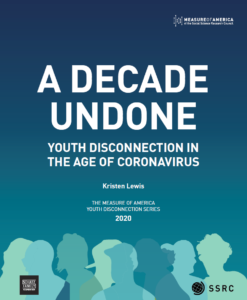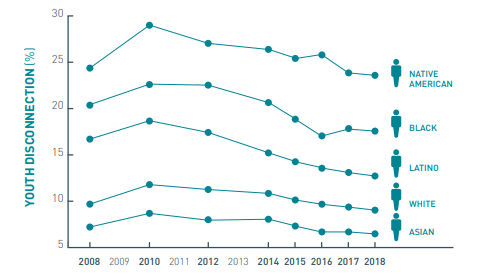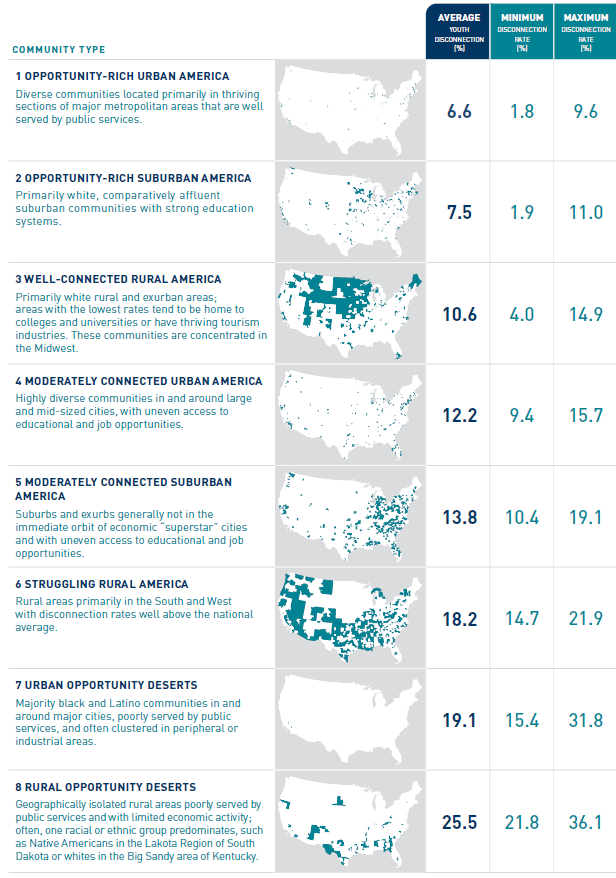New Orleans Will Give Unconditional Cash Payments To ‘Opportunity Youth’
April 2, 2021 — New Orleans Public Radio
Inequalities in Louisiana have been exacerbated by COVID-19
February 16, 2021 — The Lens NOLA
CORONAVIRUS Study: Rural Georgia County Has Nation’s Highest Rate Of ‘Youth Disconnection’
August 15, 2020 — WABE
Black communities were forgotten during the recovery from the Great Recession. We can’t let that happen again.
July 25, 2020 — Business Insider
A Decade Undone: Youth Disconnection in the Age of Coronavirus
June 15, 2020 — Philanthropy News Digest
Today’s Buzz
June 15, 2020 — NYN First Read
New study: Native American youth most likely racial, ethnic group in US to be ‘disconnected’
June 11, 2020 — Great Falls Tribune
COVID-19 could devastate nation’s youth when it comes to school, work, new report finds
June 10, 2020 — Marketplace
A Decade Undone: Youth Disconnection in the Age of Coronavirus
To see the most recent data, check out our interactive tool on youth disconnection.
LAUNCHED JUNE 10, 2020
FULL REPORT | INTERACTIVE TOOL | MEDIA RELEASE

The number of teens and young adults disconnected from both work and school in the United States fell for the eighth year in a row, from a recession-fueled high of 14.7 percent in 2010 to 11.2 percent in 2018. The Covid-19 pandemic will cause youth disconnection rates to spike dramatically. We estimate that the number of disconnected youth will easily top six million and could swell to almost one-quarter of all young people. With students physically disconnected from schools and unemployment the highest it’s been since the Great Depression, young people with the fewest resources will be left even further behind their peers and face the highest barriers to reconnection. While it is clear that young people of all stripes will suffer, low-income people of color will be the hardest hit.
Despite overall improvements in the youth disconnection rate over the last decade, the gaps between racial and ethnic groups
persisted and will be exacerbated by Covid-19. In addition, striking disparities between different geographies within the US remained. Even in economic boom times, vulnerable young people needed far more support, and in the face of Covid-19, their needs have grown.
A Decade Undone: Youth Disconnection in the Age of Coronavirus, written in the months before the pandemic, presents youth disconnection rates for the United States as a whole as well as by gender, race and ethnicity, region, state, metro area, county, and congressional district. For the first time, we also present disconnection rates for each of the country’s roughly 2,400 public use microdata areas (PUMAs), a Census Bureau-defined geography of at least 100,000 people. Using data by PUMA, we introduce a new community typology that highlights the distinct characteristics of the country’s urban, suburban, and rural areas and explores how they affect youth disconnection rates. These pre-coronavirus numbers create a map of vulnerability; they highlight where disconnection rates were already highest and therefore where the situation today is most precarious.
Because this is an election year, A Decade Undone also delves into the relationship between political participation and youth disconnection with a state-level analysis of voter turnout and disconnection rates.
KEY FINDINGS
- Nationally: The 2018 youth disconnection rate is 11.2 percent, or one in nine young people, down from 11.5 percent in 2017. The country’s disconnected youth are nearly twice as likely to live in poverty, more than three times as likely to have a disability of some kind, nine times as likely to have dropped out of high school, and more than twenty times as likely to be living in institutionalized group quarters as their connected counterparts. Disconnected young women are over four times as likely to be mothers as their connected peers.

- Race and ethnicity: Native American youth have a disconnection rate of 23.4 percent, the highest of the United States’ five major racial and ethnic groups. Black teens and young adults have the second-highest disconnection rate, 17.4 percent, followed by Latino (12.8 percent), white (9.2 percent), and Asian (6.2 percent) young people.
- Gender: Girls and young women are less likely to be disconnected than boys and young men, 10.8 percent versus 11.5 percent. But the gender gap varies by race and ethnicity. For Latino and Native American youth, young women have slightly higher disconnection rates, whereas for black and white youth, young men do. (Asian men and women’s rates are not significantly different.) Black young people have the largest gender gap of any racial or ethnic group—14.8 percent for black girls and young women, compared to 19.9 percent for their male counterparts. Native American teen girls and young women have the highest disconnection rate of any race/gender combination, 24.8 percent.
- Public use microdata areas (PUMAs): The ten best-performing PUMAs can all be found in affluent sections of large cities or in well-to-do suburbs of major metro areas, and all have youth disconnection rates below 3 percent. The ten PUMAs facing the greatest challenges have youth disconnection rates that range from 29.8 percent to 36.1 percent. Two types of communities are found in this group: low-income, majority-minority neighborhoods in large metro areas, and isolated rural areas characterized by long-term, deep poverty. PUMAs are areas defined by the US Census Bureau; they have populations of at least 100,000 people. To create these geographies, urban counties are split into many PUMAs (Los Angeles has 69, for example) and sparsely populated rural counties are joined together. The result is places with similarly-sized population groups that allow for apples-to-apples comparisons.
- Community Types: A group of PUMAs termed “rural opportunity deserts” in our typology has the highest disconnection rates, with an average of 25.5 percent. Contrary to the typical portrayal of rural areas as overwhelmingly white, 20.3 percent of youth in the country’s most disadvantaged rural areas are black, 24.4 percent are Latino, and 6.4 percent are Native American.

- States: North Dakota has the lowest youth disconnection rate of any state (5.4 percent) and Alaska has the highest (18.1 percent). Alaska experienced the largest increase in the share of disconnected young people between 2017 and 2018, 28.0 percent. The largest drop in disconnection was achieved by Utah, from 9.6 percent in 2017 to 7.3 percent in 2018, a decrease of 24.9 percent. The lowest state-level disconnection rate for young black men (Massachusetts, 11.1 percent) is still well above that same state’s rate for young white men (6.0 percent).
- Metro areas: Provo-Orem, Utah (6.1 percent), boasts the lowest disconnection rate of any metro area in the country. The highest rate of disconnection can be found in Bakersfield, California (20.8 percent).
- Counties: Rural counties have by far the highest average rate of youth disconnection, 18.1 percent; suburban counties have the lowest, 10.4 percent. County youth disconnection rates have the greatest range of any unit of geography. Iowa’s Story County, a small city, has the lowest rate of youth disconnection in the country (1.6 percent), while Georgia’s Hancock County has the highest rate in the country (80.7 percent), a 79.1-percentage-point difference.
- Congessional Districts: Massachusetts District 5, which includes suburbs north and west of Boston, has the lowest rate (4.4 percent). West Virginia District 3, which includes the southern cities of Huntington, Princeton, Bluefield, and Buckley, is home to the highest youth disconnection rate, 21.9 percent.
- Political Participation: Youth voter turnout increased between 2014 and 2018 in nearly every state, but the states where more youth are working or in school saw the greatest increase in youth civic engagement. On average, for every 1 percentage point lower a state’s disconnection rate is than another’s, its voter turnout rate increase is 1.3 percentage points higher.
RECOMMENDATIONS
Covid-19 has likely erased ten years’ progress in reducing the national youth disconnection rate in a matter of months. It is difficult, at the height of the pandemic, to make recommendations for a future whose landscape we cannot yet divine. Nonetheless, a few things are clear. The 2020 youth disconnection rate will spike, and disconnected youth and their families will be hit the hardest. Read about challenges and recommendations here.
“Mobilizing knowledge for the public good is the core mission of the SSRC,” said Alondra Nelson, president of the Social Science Research Council. “Now more than ever, as we struggle to understand and address the interlocking crises of persistent disadvantage, the disproportionate impact of Covid-19 on people of color, and our tragic history of police brutality against Black people, research like this that illuminates the nature and extent of inequalities among America’s teens and young adults is critical.”
…
“Measure of America’s reports on youth disconnection are indispensable reading for anyone who wants to understand this key public health issue. Their latest release, “A Decade Undone: Youth Disconnection in the Age of Coronavirus,” contains several excellent new features. These include youth disconnection calculations at a fine-grained level based on approximately 2,400 public use microdata areas (PUMAs), a novel way of characterizing urban, suburban, and rural communities, and associations of youth disconnection with youth voter turnout. The report frames findings from analyses of 2018 data in the context of the 2020 global pandemic and its devastating impacts on youth connections to education and employment. I know I’ll be turning to this critical resource again and again.”
…
“Even before the COVID-19 crisis, disconnected youth were at a higher risk of poor health and economic outcomes as compared to their peers. Unfortunately, the pandemic has further widened the divide for an already vulnerable community. Now more than ever, measuring and tracking disconnection rates is critical to informing our work to continue to keep young people at the forefront of opportunity.”
ACKNOWLEDGEMENTS
This report is made possible by The Schultz Family Foundation. The Schultz Family Foundation partners with like-minded businesses and community-based organizations to build a new approach to youth development and economic mobility. Through our Opportunity Youth initiative, we forge unique partnerships and invest in clear pathways to employment. By focusing on both traditional and innovative programs such as mentorship, access to housing, job readiness and community connections, the Foundation helps close the opportunity gap for these young people so they, in turn, can build communities and families that prosper into the next generation.
Youth, Disconnected: Coronavirus Shutdown Leaves Some Behind
May 1, 2020 — Pew Charitable Trusts